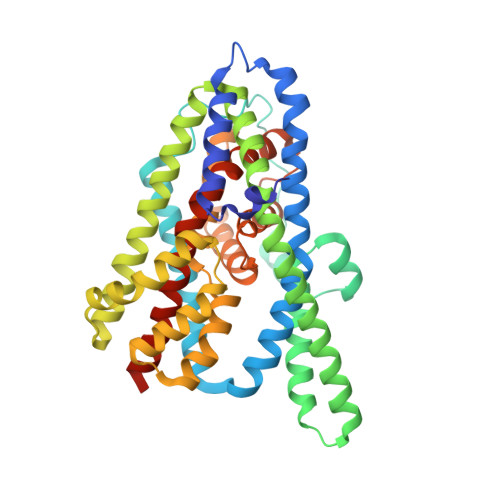Glutamate transporters have a chloride channel with two hydrophobic gates.
Chen, I., Pant, S., Wu, Q., Cater, R.J., Sobti, M., Vandenberg, R.J., Stewart, A.G., Tajkhorshid, E., Font, J., Ryan, R.M.(2021) Nature 591: 327-331
- PubMed: 33597752
- DOI: https://doi.org/10.1038/s41586-021-03240-9
- Primary Citation of Related Structures:
6WYJ, 6WYK, 6WYL, 6WZB, 6X01 - PubMed Abstract:
Glutamate is the most abundant excitatory neurotransmitter in the central nervous system, and its precise control is vital to maintain normal brain function and to prevent excitotoxicity 1 . The removal of extracellular glutamate is achieved by plasma-membrane-bound transporters, which couple glutamate transport to sodium, potassium and pH gradients using an elevator mechanism 2-5 . Glutamate transporters also conduct chloride ions by means of a channel-like process that is thermodynamically uncoupled from transport 6-8 . However, the molecular mechanisms that enable these dual-function transporters to carry out two seemingly contradictory roles are unknown. Here we report the cryo-electron microscopy structure of a glutamate transporter homologue in an open-channel state, which reveals an aqueous cavity that is formed during the glutamate transport cycle. The functional properties of this cavity, combined with molecular dynamics simulations, reveal it to be an aqueous-accessible chloride permeation pathway that is gated by two hydrophobic regions and is conserved across mammalian and archaeal glutamate transporters. Our findings provide insight into the mechanism by which glutamate transporters support their dual function, and add information that will assist in mapping the complete transport cycle shared by the solute carrier 1A transporter family.
Organizational Affiliation:
Transporter Biology Group, School of Medical Sciences, Faculty of Medicine and Health, University of Sydney, Sydney, New South Wales, Australia.















